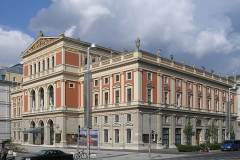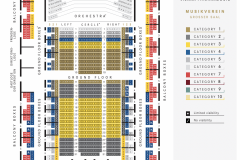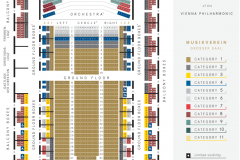Gewandhaus Orchestra Leipzig
Mo | Tu | We | Th | Fr | Sa | Su |
The Gewandhaus Orchestra Leipzig is one of the oldest and most prestigious orchestras in Germany, with a rich history spanning over 275 years. It has played a central role in the development of classical music, performing works by legendary composers such as Beethoven, Brahms, and Mendelssohn. Known for its exceptional sound and artistic excellence, the orchestra is a staple of Leipzig’s musical life. Under the direction of renowned conductors, the Gewandhaus Orchestra continues to captivate audiences worldwide with its dynamic performances, blending traditional repertoire with contemporary pieces. Whether in its home at the Gewandhaus or on international tours, this orchestra represents the pinnacle of orchestral music, delighting audiences with its precision, passion, and technical brilliance.
Program and cast
10 November 2025
PERFORMERS
Gewandhaus Orchestra Leipzig
Andris Nelsons, Conductor
Seong-Jin Cho, Piano
PROGRAM
JOSEPH HAYDN
Symphony in E-flat Major, Hob. I:22, "The Philosopher"
FELIX MENDELSSOHN BARTHOLDY
Piano Concerto No. 1 in G Minor, Op. 25
– Intermission –
JOHANNES BRAHMS
Symphony No. 3 in F Major, Op. 90
Ends around 9:10 PM
11 November 2025
PERFORMERS
Gewandhaus Orchestra Leipzig
Andris Nelsons, Conductor
Augustin Hadelich, Violin
PROGRAM
JOHANNES BRAHMS
Violin Concerto in D Major, Op. 77
– Intermission –
DORA PEJAČEVIĆ
Symphony in F-sharp Minor, Op. 41
Ends around 9:30 PM
18 May 2026
PERFORMERS
Gewandhaus Orchestra Leipzig
Andris Nelsons, Conductor
Yulianna Avdeeva, Piano
PROGRAM
SERGEI RACHMANINOFF
Piano Concerto No. 2 in C Minor, Op. 18
– Intermission –
DMITRI SHOSTAKOVICH
Symphony No. 10 in E Minor, Op. 93
Ends around 9:30 PM
19 May 2026
PERFORMERS
Gewandhaus Orchestra Leipzig
Andris Nelsons, Conductor
Sarah Wegener, Soprano, (Sieglinde)
Klaus Florian Vogt, Tenor, (Siegmund)
Vitalij Kowaljow, Bass, (Hunding)
PROGRAM
ROBERT SCHUMANN
Symphony No. 1 in B-flat Major, Op. 38, "Spring Symphony"
– Intermission –
RICHARD WAGNER
Die Walküre - Act 1
Ends around 9:30 PM
Musikverein Golden Hall
This building is located on Dumbastraße/Bösendorferstraße behind the Hotel Imperial near the Ringstraße boulevard and the Wien River, between Bösendorferstraße and Karlsplatz. However, since Bösendorferstraße is a relatively small street, the building is better known as being between Karlsplatz and Kärntner Ring (part of Ringstraße loop). It was erected as the new concert hall run by the Gesellschaft der Musikfreunde, on a piece of land provided by Emperor Franz Joseph I of Austria in 1863. The plans were designed by Danish architect Theophil Hansen in the Neoclassical style of an ancient Greek temple, including a concert hall as well as a smaller chamber music hall. The building was inaugurated on 6 January, 1870. A major donor was Nikolaus Dumba whose name the Austrian government gave to one of the streets surrounding the Musikverein.
Great Hall - Golden Hall
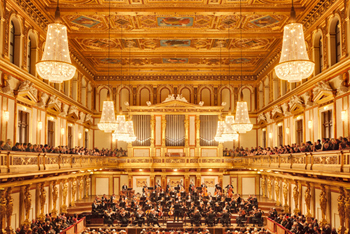 “As high as any expectations could be, they would still be exceeded by the first impression of the hall which displays an architectural beauty and a stylish splendour making it the only one of its kind.” This was the reaction of the press to the opening of the new Musikverein building and the first concert in the Großer Musikvereinssaal on 6 January 1870.
“As high as any expectations could be, they would still be exceeded by the first impression of the hall which displays an architectural beauty and a stylish splendour making it the only one of its kind.” This was the reaction of the press to the opening of the new Musikverein building and the first concert in the Großer Musikvereinssaal on 6 January 1870.
The impression must have been overwhelming – so overwhelming that Vienna’s leading critic, Eduard Hanslick, irritatingly brought up the question of whether this Großer Musikvereinssaal “was not too sparkling and magnificent for a concert hall”. “From all sides spring gold and colours.”
Brahms Hall
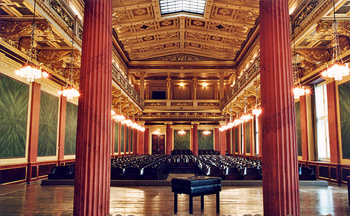 "In order not to promise too much it can be said that it has been made into the most beautiful, most magnificent, perfect example of a chamber concert hall that any of us knows in the world.” This was the reaction of a Vienna daily newspaper in October 1993 as the Brahms-Saal was presented to the public after extensive renovation work.
"In order not to promise too much it can be said that it has been made into the most beautiful, most magnificent, perfect example of a chamber concert hall that any of us knows in the world.” This was the reaction of a Vienna daily newspaper in October 1993 as the Brahms-Saal was presented to the public after extensive renovation work.
The surprise was perfect. It was a completely new hall. In contrast to the Grosse Musikvereinssaal, the Brahms-Saal had changed its appearance quite considerably over the years. When and how it acquired that slightly melancholy duskiness that was known to music lovers before 1993 cannot be precisely documented.
Glass Hall
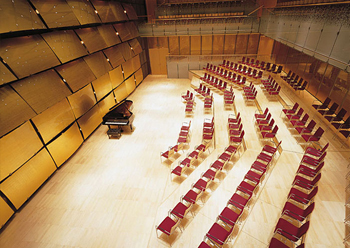 As a venue for events from concerts to luxury banquets, the Glass Hall / Magna Auditorium is not only the largest of the Musikverein's 4 new halls but also the most flexible in terms of usage.
As a venue for events from concerts to luxury banquets, the Glass Hall / Magna Auditorium is not only the largest of the Musikverein's 4 new halls but also the most flexible in terms of usage.
Hub podiums enable the smooth transformation of the concert hall into a conference centre, the cinema into a ballroom, or the stage into a catwalk. State-of-the-art equipment for sound, lighting, video and widescreen digital projection provide the ideal conditions for half-scenic productions.
The Glass Hall / Magna Auditorium was designed by the Viennese architect Wilhelm Holzbauer. With a height of 8 metres, the hall (including the gallery) can play host to up to 380 visitors.

 EN
EN DE
DE IT
IT FR
FR ES
ES RU
RU JP
JP RO
RO
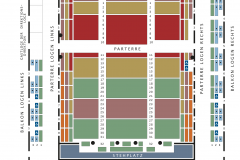 Seating plan
Seating plan 